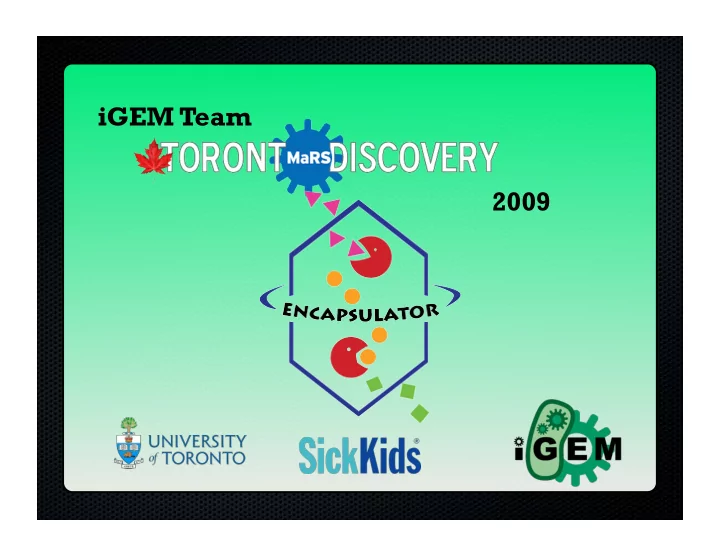

iGEM Team 2009
Who are we?
Objectives of our Project • Explore the concept of enzyme channeling • Identify novel strategies to promote enzyme channeling • Design a proof of concept system • Model and Characterized proposed systems
Rationale: Why Enzyme Channeling? What is it? • The shuttling of products from one enzymatic reaction directly to a second with minimal diffusion. Substrate Intermediate Product
Rationale: Why Enzyme Channeling? Why Should We Care? • Applications • Improving Efficiencies of Enzyme Pairs with a Low K1 • Pathway Redirection Alpha-ketoglutarate Dehydrogenase • Sequestering of Synthetic Pathways.
Optimization of Enzyme Channeling So what are ways of optimizing Enzyme Channeling? • Fusion Proteins • Protein Scaffold
Microcompartments So what are Microcompartments? • Microcompartments are small capsules formed by proteins • Some have the ability to self assemble • Contains pores • Occurs naturally in some species of bacteria • Channeling Unfavourable reactions (Rubisco in Blue Green) • Toxic / Highly Reactive Intermediates ( T.maritima )
Microcompartment: Problems? ? Challenges of using Microcompartments in a System • Assembly methods unknown • Targeting
The Encapsulator Encapsulin Protein from Thermotoga maritima. o 250 A Rationale for the Use of Encapsulin • Targeting Sequence has been elucidated • On the C-terminal end of protein to be encapsulated • Self-assembles • Relatively well characterized
Project Overview Objectives 1) Design, construct and characterize a microcompartment expression system in E. coli . 2) Target a fluorescent marker (eCFP) to the micro-compartment. 3) Identify and prioritize candidate enzyme pairs for channeling. 4) Apply channeling to selected enzyme pairs.
Design Overview Stacy Hung eCFPtgt + Encapsulin Control Module
Control Module • Constitutive promoter (J23100) • Ribosomal binding sites (B0034) • TetR gene (C0040) • LacI gene (C0012) • Transcriptional terminators (B0010, B0012)
Controlled Expression System
Modeling – Simulations Farhan Raja Accumulation of Encapsulin at different concentrations of aTc Encapsulin monomer concentration (mol/L)
Modeling – Simulations Accumulation of eCFP monomer at different concentrations of IPTG eCFP concentration (mol/L)
Encapsulin Construct • TetR repressible promoter (R0040) • Repression inhibited by aTc • Encapsulin gene (K192000)
eCFPtgt Construct • LacI repressible promoter (R0010) • Repression inhibited by IPTG • eCFPtgt (K192001) • Encapsulin target sequence • LVA degradation tag
Proof of Concept Multiple alignment of extension sequences of DyP and ferritin-like proteins Sutter et al. (2008)
Proof of Concept CFP + LVA degradation tag, Encapsulin targeting sequence
Proof of Concept Degradation occurs, no Encapsulin protects, fluorescence florescence
“Open source” targeted encapsulation Targeting sequence Protein of choice Ready for localization!
Search for Suitable Enzyme Pairs Bioinformatics Objective: Identify and prioritize candidate enzyme pairs for channeling ? ? + Meah Gao
Search for Suitable Enzyme Pairs Considerations: 1. Specific thermodynamic properties 2. Toxic metabolic intermediates 3. Gene fusion products ? ? + Further refinements: 1. Biochemically non-adjacent enzymes removed 2. Molecular weight > 100 kDa removed
Suitable Enzyme Pairs EC2 Pathway Major Product Applications 6.3.4.4 adenylosuccinate Alanine and aspartate metabolism 1.2.1.10 Butanoyl-coA Butanoate metabolism 2.6.1.52 Phosphoserine Glycine, serine and threonine metabolism 4.1.3.1 Isocitrate Glyoxylate and dicarboxylate metabolism 3.5.4.9 Formyl-THF One carbon pool by folate 3.5.4.9 Formyl-THF One carbon pool by folate 5.3.1.12 D-Glucuronate Pentose and glucuronate interconversions 5.1.3.1 D-ribolose-5P Pentose phosphate pathway 5.3.1.9 a-glucose-6P Pentose phosphate pathway Phenylalanine, tyrosine and tryptophan 4.2.1.51 Phenyl-pyruvate biosynthesis 2.7.2.15 Propanoate Food preservatives Propanoate metabolism Propanoate metabolism/Pyruvate 2.7.2.1 Propanoate/acetate Energy metabolism 4.1.1.23 UMP Pyrimidine metabolism 2.4.2.3 Uridine Pyrimidine metabolism 3.1.3.12 a,a trehalose biotech:overproduction Starch and sucrose metabolism Flavor enhancer, 2.7.2.11 Urea cycle and metabolism of amino groups Glutamate Nutrient, Plant growth
Alternative Microcompartments Clostridium kluyveri 1. Gene cluster contains only 7 genes, including 2 for microcompartment proteins 2. Presence of an intact and functional microcompartment enclosing enzymes 3. Targeting sequence?
Experimental Results • Encapsulin construct • Encapsulin gene submitted to 2009 iGEM Parts Registry (K192000) Kenny Zhan • eCFPtgt construct • eCFPtgt synthesized • Additional work required Yen Leung • Control module • Partially assembled • Additional work required
Conclusions • Created a conceptual system theoretically capable of engineering metabolic channeling within bacteria cells • Created a short list of enzymes amenable to targeted encapsulation • Modeled various components in silico • Submitted a new part to the registry, Encapsulin (K192000)
Future Directions • Narrow search for enzyme pair • Test alternative microcompartments • Model Encapsulin assembly • eCFP construct • Characterization of control module • Proof of Concept
Thank you! Left to right: Farhan, James, Graham, John, Yen, Kenny, Meah, Stacy
Recommend
More recommend